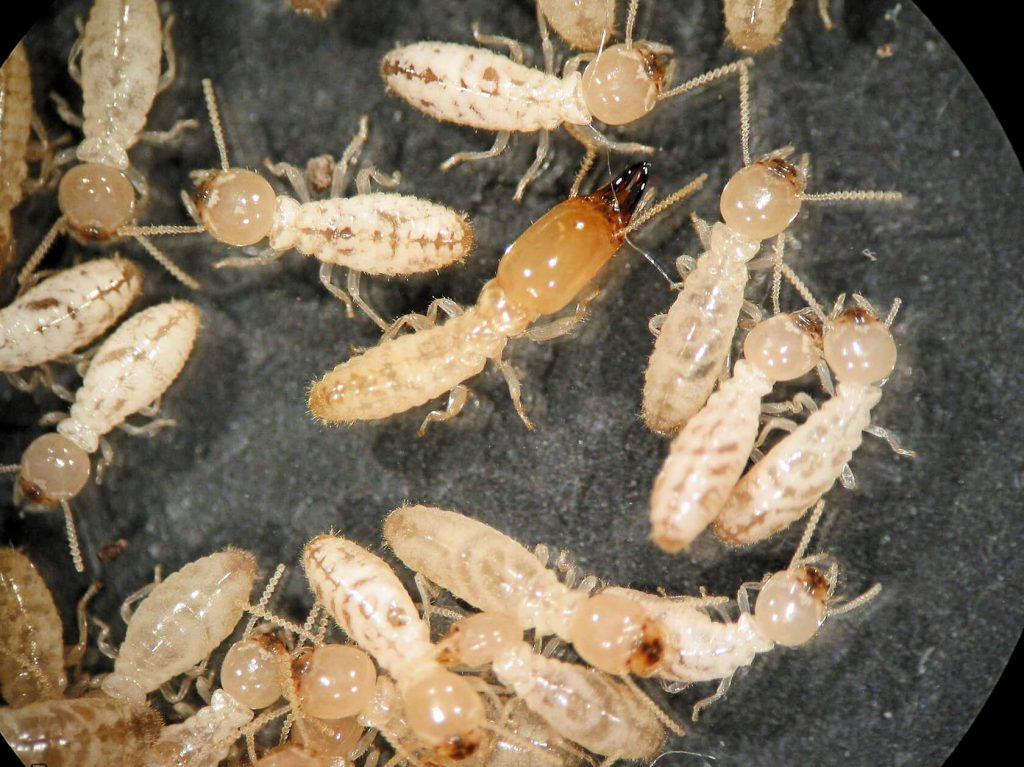
Over the weekend I noticed weak-flying subterranean termite swarmers drifting through the air. This is not as much a fearful observation as it is one of keeping a vigilant eye out for this wood-destroying insect pest. Let’s take a look at this insect and highlight what you can do to keep it out of your home.
At this time of year, subterranean termite colonies are sending out their winged reproductive adults – termite “kings” and “queens” – to mate and, if all goes well, set up a new kingdom of their own. These reproductive adults emerge from a colony, fly, mate and then drop to the ground and shed their wings. You may have seen these tiny de-winged “royal couples” as they ran after each other on the ground looking for a place to hide. While termites may look a little like flying ants at this stage, careful examination will show you that they thick waists, straight antennas and wings that are equal in size. They nest in the soil where they are protected from predators and dehydration. Central to the subterranean termite colony is the queen as she lays the eggs that produce the various members in a colony. A majority of the colony are blind workers whose job it is to find food. Special soldier termites provide protection for the colony with large, wicked-looking jaws. From the colony, workers fan out in search of wood and other cellulose-containing material. With the help of special protozoa in their gut, termites are able to digest and use cellulose as food.
Often damage by subterranean termites is not evident and careful inspection must be employed to detect their presence. However, worker termites can construct mud tubes that extend from the ground to a wooden structure as a safe passageway that protects these industrious, yet frail insects from predators and dehydration. These mud tubes may be seen spanning foundations, where concrete slab floors are cracked, or where pipes and utilities enter a house. Subterranean termites feed by following the grain of the wood and consuming the softer part of the wood. Hollowed out galleries can be detected by tapping with a screwdriver handle. You may even find that a screwdriver will break through these hollow areas in the wood.
Prevention is always a smart move to deter termites. Preconstruction treatments, baits, and termiticide barriers are all strategies that can be employed that provide preventative protection. Regular inspections by qualified professional pest control companies are a good idea for homeowners. Have at least three companies make inspections, and if you need to go with one, also ask for references, insurance information, and copies of appropriate certifications and licenses. Also make sure that they sit down with you to go over the treatment options and guarantees, supply you with the pesticide labels, and show you proof of evidence of active infestations. While swarms of flying termites outside your house do not necessarily mean that your home has an infestation, termites are everywhere, and prudent investigation and protective measures will pay off to help keep your home termite-free. For additional details on subterranean termites, become an informed consumer and check out our EDIS fact sheet entitled “Subterranean Termites” by W. Chan, P. G. Koehler and C. L. Tucker located at https://edis.ifas.ufl.edu/pdffiles/IG/IG09700.pdf . For more information on all types of pest control information, or to ask a question, please visit https://www.facebook.com/CharlotteMGLifeline/. Ralph E. Mitchell is the Director/Horticulture Agent for the UF/IFAS Charlotte County Extension Service. He can be reached at 941-764-4344 or ralph.mitchell@charlottecountyfl.gov.
Resources:
Koehler, P. G & Tucker, C. L. (2017) Subterranean Termites. The University of Florida Extension Service, IFAS.
Koehler, P. G. & Pereira, R. (2017) How to Buy Pest Control Services. The University of Florida Extension Service, IFAS.
 0
0
